The Use of Antioxidant Potential of Chokeberry Juice in Creating Pro-Healthy Dried Apples by Hybrid (Convection-Microwave-Vacuum) Method
Abstract
:1. Introduction
2. Results
3. Discussion
4. Material and Methods
4.1. Material
4.2. Osmotic Dehydration
4.3. Drying
4.4. Chemical Analyses
4.5. Dry Matter Content
4.6. Determination of Vitamin C (L-Ascorbic Acid) Content
4.7. Determination of Total Polyphenols Content by the Folin–Ciocalteu Method
4.8. Determination the Ability of Extracts to Inactivate Stable DPPH Radicals
4.9. Sensory Evaluation
4.10. Statistical Analyses
5. Conclusions
Author Contributions
Funding
Acknowledgments
Conflicts of Interest
References
- Plumb, J.; Pigat, S.; Bompola, F.; Cushen, M.; Pinchen, H.; Nørby, E.; Astley, S.; Lyons, J.; Kiely, M.; Finglas, P. eBASIS (bioactive substances in food information systems) and bioactive intakes: Major updates of the bioactive compound composition and beneficial bioeffects database and the development of a probabilistic model to assess intakes in Europe. Nutrients 2017, 9, 320. [Google Scholar] [CrossRef] [PubMed] [Green Version]
- Cassiday, L. Clean label: The next generation. INFORM 2017, 28. [Google Scholar] [CrossRef]
- Nascimento, K.; Paes, S.; Augusta, I.M. A review ‘clean labeling’: Applications of natural ingredients in bakery products. J. Food Nutr. Res. 2018, 6, 285–294. [Google Scholar] [CrossRef]
- Ferretti, G.; Turco, I.; Bacchetti, T. Apple as a source of dietary phytonutrients: Bioavailability and evidence of protective effects against human cardiovascular disease. Food Nutr. Sci. 2014, 5, 1234–1246. [Google Scholar] [CrossRef] [Green Version]
- Barreira, J.C.M.; Arraibi, A.A.; Ferreira, I.C.F.R. Bioactive and functional compounds in apple pomace from juice and cider manufacturing: Potential use in dermal formulations. Trends Food Sci. Technol. 2019, 90, 76–87. [Google Scholar] [CrossRef]
- Choo, C.O.; Chua, B.L.; Figiel, A.; Jałoszyński, K.; Wojdyło, A.; Szumny, A.; Łyczko, J.; Chong, C.H. Hybrid drying of Murraya koenigii leaves: Energy consumption, antioxidant capacity, profiling of volatile compounds and quality studies. Processes 2020, 8, 240. [Google Scholar] [CrossRef] [Green Version]
- Betoret, E.; Calabuig-Jiménez, L.; Barrera, C.; Rosa, M.D. Sustainable drying technologies for the development of functional foods and preservation of bioactive compounds. In Sustainable Drying Technologies; InTech: London, UK, 2016; pp. 38–57. [Google Scholar]
- Sabarez, H. Drying of food materials. Ref. Modul. Food Sci. 2016, 1–10. [Google Scholar] [CrossRef]
- Yadav, A.K.; Singh, S.V. Osmotic dehydration of fruits and vegetables: A review. J. Food Sci. Technol. 2014, 51, 1654–1673. [Google Scholar] [CrossRef] [PubMed]
- Kowalska, J.; Roszkowska, S.; Lenart, A.; Kowalska, H. The influence of chokeberry juice and inulin as osmotic-enriching agents in pre-treatment on polyphenols content and sensory quality of dried strawberries. Agric. Food Sci. 2019, 28, 190–199. [Google Scholar] [CrossRef]
- Andrzejewska, J.; Sadowska, K.; Klóska, Ł.; Rogowski, L. The effect of plant age and harvest time on the content of chosen components and antioxidative potential of black chokeberry fruit. Acta Sci. Polonum Hortorum Cultus 2015, 14, 105–114. [Google Scholar]
- Jurikova, T.; Mlcek, J.; Skrovankova, S.; Sumczynski, D.; Sochor, J.; Hlavacova, I.; Snopek, L.; Orsavova, J. Fruits of black chokeberry Aronia melanocarpa in the prevention of chronic diseases. Molecules 2017, 22, 944. [Google Scholar] [CrossRef]
- Banach, M.; Wiloch, M.; Zawada, K.; Cyplik, W.; Kujawski, W. Evaluation of antioxidant and anti-inflammatory activity of anthocyanin-rich water-soluble aronia dry extracts. Molecules 2020, 25, 4055. [Google Scholar] [CrossRef]
- Buran, T.J.; Sandhu, A.; Li, Z.; Rock, C.; Yang, W.; Gu, L. Adsorption/desorption characteristics and separation of anthocyanins and polyphenols from blueberries using macroporous adsorbent resins. J. Food Eng. 2014, 128, 167–173. [Google Scholar] [CrossRef]
- Gutowska, I.; Marszałek, P.; Baranowska-Bosiacka, I.; Łukomska, A.; Goschorska, M.; Janda, K. Fruit and vegetables—fresh or processed—which are a better source of vitamin C? Pomeranian J. Life Sci. 2019, 65, 5–9. [Google Scholar] [CrossRef] [Green Version]
- Macan, A.M.; Kraljević, T.G.; Raić-Malić, S. Therapeutic perspective of vitamin C and its derivatives. Antioxidants 2019, 8, 247. [Google Scholar] [CrossRef] [Green Version]
- Carr, A.C.; Rowe, S. Factors affecting vitamin C status and prevalence of deficiency: A global health perspective. Nutrients 2020, 12, 1963. [Google Scholar] [CrossRef]
- Cory, H.; Passarelli, S.; Szeto, J.; Tamez, M.; Mattei, J. The role of polyphenols in human health and food systems: A mini-review. Front. Nutr. 2018, 5, 87. [Google Scholar] [CrossRef] [Green Version]
- Fraga, C.G.; Croft, K.D.; Kennedy, D.O.; Tomás-Barberán, F.A. The effects of polyphenols and other bioactives on human health. Food Funct. 2019, 10, 514–528. [Google Scholar] [CrossRef] [Green Version]
- Urbańska, B.; Kowalska, J. Comparison of the total polyphenol content and antioxidant activity of chocolate obtained from roasted and unroasted cocoa beans from different regions of the world. Antioxidatnt 2019, 8, 283. [Google Scholar] [CrossRef] [Green Version]
- Kelly, N.P.; Kelly, A.L.; O’Mahony, A.O. Strategies for enrichment and purification of polyphenols from fruit-based materials. Trends Food Sci. Technol. 2019, 83, 248–258. [Google Scholar] [CrossRef]
- Rusconi, M.; Conti, A. Theobroma cacao L., the food of the goods: A scientific approach beyond myths and claims. Pharmacol. Res. 2010, 61, 5–13. [Google Scholar] [CrossRef]
- Samborska, K.; Eliasson, L.; Marzec, A.; Kowalska, J.; Piotrowski, D.; Lenart, A.; Kowalska, H. The effect of adding berry fruit juice concentrates and by-product extract to sugar solution on osmotic dehydration and sensory properties of apples. J. Food Sci. Technol. 2019, 56, 1927–1938. [Google Scholar] [CrossRef] [Green Version]
- Sharif, N.; Pirouzifard, M.; Alizadeh, M.B.; Esmaiili, M. Concentrated fruit juice as an osmotic solution in production of candied apple. Agro Food Ind. Hi Tech 2013, 24, 73–76. [Google Scholar]
- Lech, K.; Michalska, A.; Wojdyło, A.; Nowicka, P.; Figiel, A. The influence of the osmotic dehydration process on physicochemical properties of osmotic solution. Molecules 2017, 22, 2246. [Google Scholar] [CrossRef] [Green Version]
- Silva, K.S.; Fernandes, M.A.; Mauro, M.A. Effect of calcium on the osmotic dehydration kinetics and quality of pineapple. J. Food Eng. 2014, 134, 37–44. [Google Scholar] [CrossRef] [Green Version]
- Kunachowicz, H.; Przygoda, B.; Nadolna, I.; Iwanow, K. Tables of the Composition and Nutritional Value of Food; Medical Publishing House PZWL: Warsaw, Poland, 2005. (In Polish) [Google Scholar]
- Plocharski, W.; Ciok, J.; Groele, B.; Markowski, J.; Rutkowski, K. Fruit, vegetables, juices—their energy and nutritional value compared to the requirement of energy and nutrients. Part VI. Labeling—possible influence on consumer’s choices. Ferment. Fruit Veg. Ind. 2014, 58, 16–19. [Google Scholar]
- Noichinda, S.; Bodhipadma, K.; Mahamontri, C.; Narongruk, T.; Ketsa, S. Light during storage prevents loss of ascorbic acid, and increases glucose and fructose levels in Chinese kale (Brassica oleracea var. alboglabra). Postharvest Biol. Technol. 2007, 44, 312–315. [Google Scholar] [CrossRef]
- Ignat, T.; Schmilovitch, Z.; Fefoldi, J.; Steiner, B.; Alkalai-Tuvia, S. Non-destructive measurement of ascorbic acid content in bell peppers by VIS-NIR and SWIR spectrometry. Postharvest Biol. Technol. 2012, 74, 91–99. [Google Scholar] [CrossRef]
- Al-Musharfi, N.; Al-Wahaibi, H.; Khan, S. Comparison of ascorbic acid, total phenolic content and antioxidant activities of fresh juices of six fruits grown in oman. J. Food Process. Technol. 2015, 6, 513. [Google Scholar] [CrossRef] [Green Version]
- Cvetković, B.R.; Jokanović, M.R. Effect of preservation method and storage condition on ascorbic acid loss in beverages. Acta Period. Technol. 2009, 40, 1–7. [Google Scholar] [CrossRef]
- Kaliś, K. Dual action of vitamin C versus degradationand supplementation. Hyg. Exp. Med. 2015, 69, 1239–1244. [Google Scholar]
- Średnicka-Tober, D.; Kazimierczak, R.; Rembiałkowska, E.; Strok, T.; Świąder, K.; Hallmann, E. Bioactive compounds in organic apple juices enriched with chokeberry and green tea extract. J. Res. Appl. Agric. Eng. 2017, 62, 173–177. [Google Scholar]
- Rząca, M.; Witrowa–Rejchert, D. Low temperature drying of food. Food Ind. 2007, 61, 30–35. (In Polish) [Google Scholar]
- Gamboa, J.; Megias, R.; Soria, A.C.; Olano, A.; Montilla, A.; Villamiel, M. Impact of processing conditions on the kinetic of vitamin C degradation and 2-furoylmethyl amino acid formation in dried strawberries. Food Chem. 2014, 153, 164–170. [Google Scholar] [CrossRef]
- Regulation (EU) No 1169/2011 of the European Parliament and of the council of 25 October 2011 on the provision of food information to consumers, amending Regulations (EC) No 1924/2006 and (EC) No 1925/2006 of the European Parliament and of the Council, and repealing Commission Directive 87/250/EEC, Council Directive 90/496/EEC, Commission Directive 1999/10/EC, Directive 2000/13/EC of the European Parliament and of the Council, Commission Directives 2002/67/EC and 2008/5/EC and Commission Regulation (EC) No 608/200, L 304. Off. J. Eur. Union 2011, 54. [CrossRef]
- Ciurzyńska, A.; Lenart, A.; Kawka, P. Influence of freeze-drying temperature and drying methods on selected properties of dried pumpkin. Acta Agrophys. 2013, 20, 39–51. [Google Scholar]
- De Bruijn, J.; Rivas, F.; Rodriguez, Y.; Loyola, C.; Flores, A.; Melin, P.; Borquez, R. Effect of vacuum microwave drying on the quality and storage stability of strawberries. J. Food Process. Preserv. 2015, 40, 1104–1115. [Google Scholar] [CrossRef]
- Udomkun, P.; Nagle, M.; Mahayothee, B.; Nohr, D.; Koza, A.; Müller, J. Influence of air drying properties on non-enzymatic browning, major bio-active compounds and antioxidant capacity of osmotically pretreated papaya. LWT Food Sci. Technol. 2015, 60, 914–922. [Google Scholar] [CrossRef]
- Safafar, H.; van Wagenen, J.; Møller, P.; Jacobsen, C. Carotenoids, phenolic compounds and tocopherols contribute to the antioxidative properties of some microalgae species grown on Industrial Wastewater. Mar. Drugs 2015, 13, 7339–7356. [Google Scholar] [CrossRef] [Green Version]
- De Bruijn, J.; Bórquez, R. Quality retention in strawberries dried by emerging dehydration methods. Food Res. Int. 2014, 63, 42–48. [Google Scholar] [CrossRef]
- Chandrasekaran, S.; Ramanathan, S.; Basak, T. Microwave food processing—A review. Food Res. Int. 2013, 52, 243–261. [Google Scholar] [CrossRef]
- Wojdyło, A.; Oszmiański, J. Antioxidant activity modulated by polyphenol contents in apple and leaves during fruit development and ripening. Antioxidants 2020, 9, 567. [Google Scholar] [CrossRef]
- Nowacka, M.; Witrowa-Rajchert, D.; Ruła, J. The influence of technological processes on antioxidant activity and polyphenols content of apple tissue. Technol. Prog. Food Process. 2011, 2, 12–15. [Google Scholar]
- Kowalska, H.; Marzec, A.; Kowalska, J.; Ciurzyńska, A.; Samborska, K.; Lenart, A. Rehydration properties of hybrid method dried fruit and enriched by natural component. Int. Agrophys. 2018, 32, 1–8. [Google Scholar] [CrossRef]
- Michalska, A.; Lech, K.; Figiel, A.; Łysiak, G.P. The Influence of selected drying methods on the physical properties of dried apples cv. Jonagold grown in different locations in Europe. Int. J. Food Eng. 2017, 13. [Google Scholar] [CrossRef]
- De Castro, D.S.; Aires, J.E.F.; Aires, K.L.C.A.F.; Silva, A.F., Jr.; da Silva, W.P.; Gomes, J.P. Physical and chemical changes in guava raisin (Psidum guajaval.) produced by osmotic dehydration and drying convective. Aust. J. Crop Sci. 2016, 10, 1449–1454. [Google Scholar] [CrossRef]
- Sidor, A.; Drożdżyńska, A.; Brzozowska, A.; Szwengiel, A.; Gramza-Michałowska, A. The efect of plant additives on the stability of polyphenols in cloudy and clarified juices from black chokeberry (Aronia melanocarpa). Antioxidants 2020, 9, 801. [Google Scholar] [CrossRef]
- Corollaro, M.L.; Endrizzi, I.; Bertolini, A.; Aprea, E.; Demattè, M.L.; Costa, F.; Biasioli, F.; Gasperi, F. Sensory profiling of apple: Methodological aspects, cultivar characterisation and postharvest changes. Postharvest Biol. Technol. 2013, 77, 111–120. [Google Scholar] [CrossRef]
- Kowalska, H.; Marzec, A.; Kowalska, J.; Ciurzyńska, A.; Czajkowska, K.; Cichowska, J.; Rybak, K.; Lenart, A. Osmotic dehydration of honeoye strawberries in solutions enriched with natural bioactive molecules. LWT Food Sci. Technol. 2017, 85, 500–505. [Google Scholar] [CrossRef]
- International Organization for Standardization. Fruit and Vegetable Products—Determination of Dry Matter Content by Drying under Reduced Pressure and of Water Content by Azeotropic Distillation; PN-ISO—1026: 2000; International Organization for Standardization: Geneva, Switzerland, 2000. (In Polish) [Google Scholar]
- Polish Committee for Standardization. Food Products—Determination of Vitamin C Content; PN-A-04019:1998; Polish Committee for Standardization: Warsaw, Poland, 1998. (In Polish) [Google Scholar]
- Van der Sluis, A.A.; Dekker, M.; Skrede, G.; Jongen, W.M.F. Activity and concentration of polyphenolic antioxidants in apple juice. Effect of existing production methods. J. Agric. Food Chem. 2002, 50, 7211–7219. [Google Scholar] [CrossRef]
- Wu, L. Effect of chlorogenic acid on antioxidant activity of Flos Lonicerae extracts. J. Zhejiang Univ. Sci. B. 2007, 8, 673–679. [Google Scholar] [CrossRef] [Green Version]
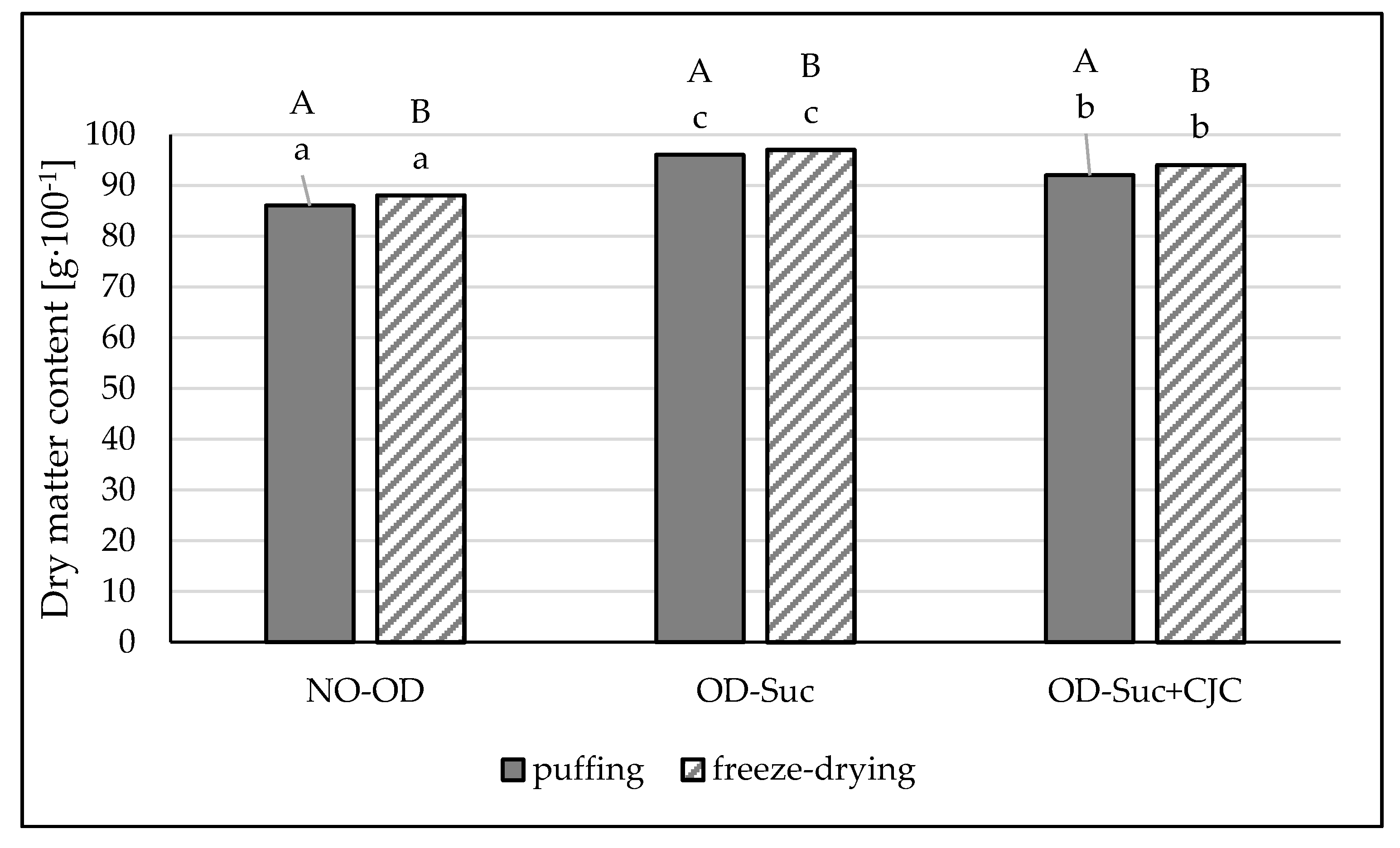
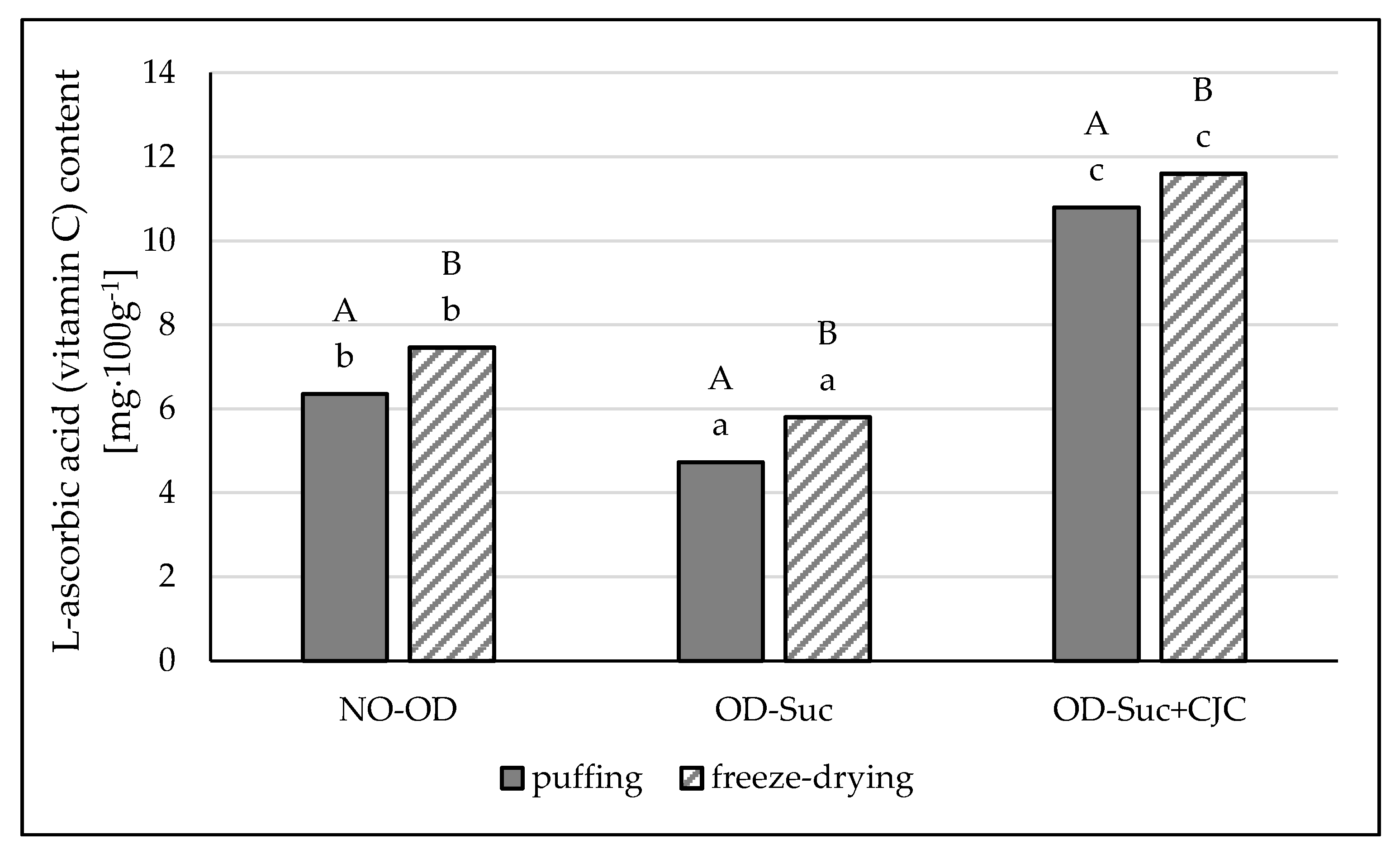
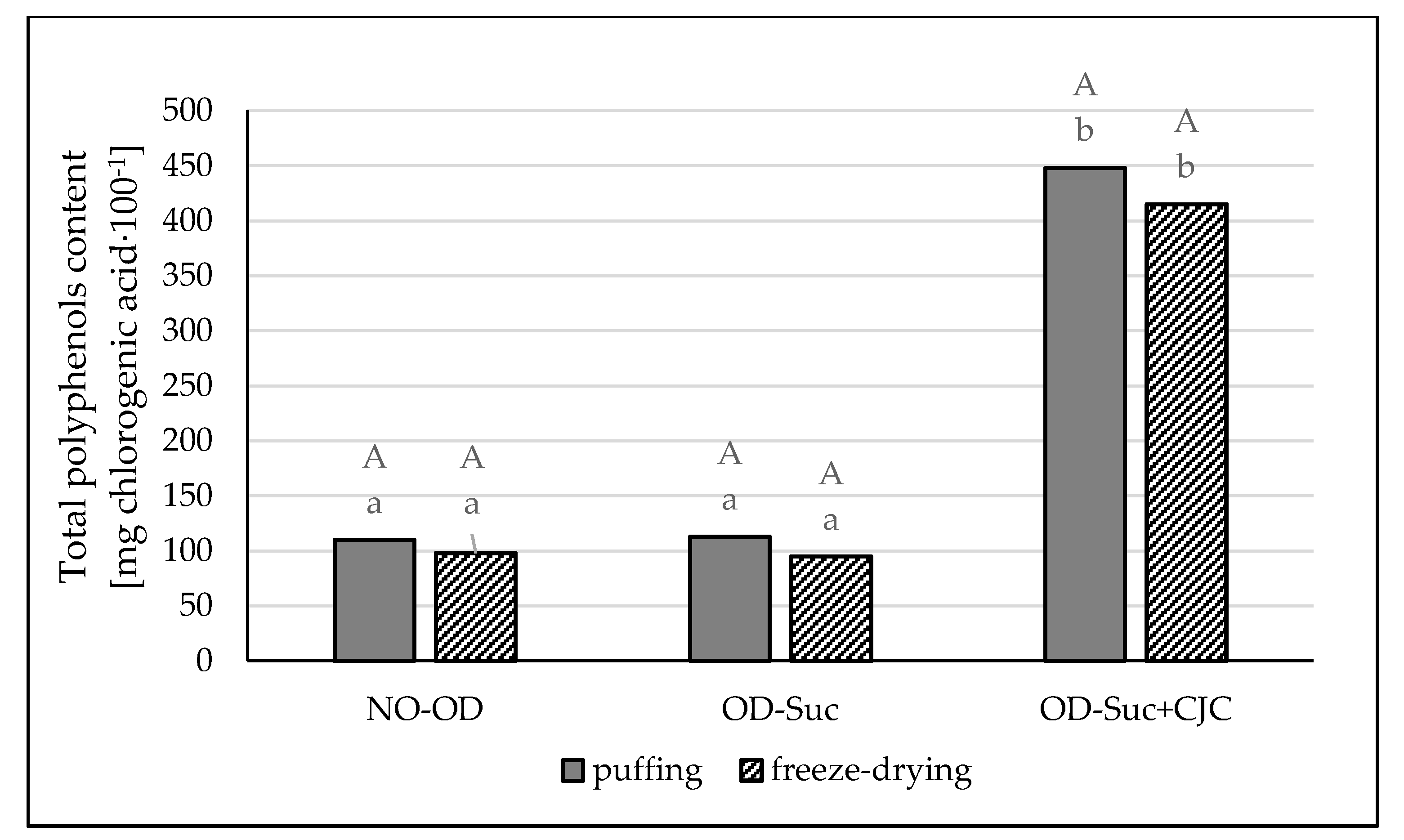
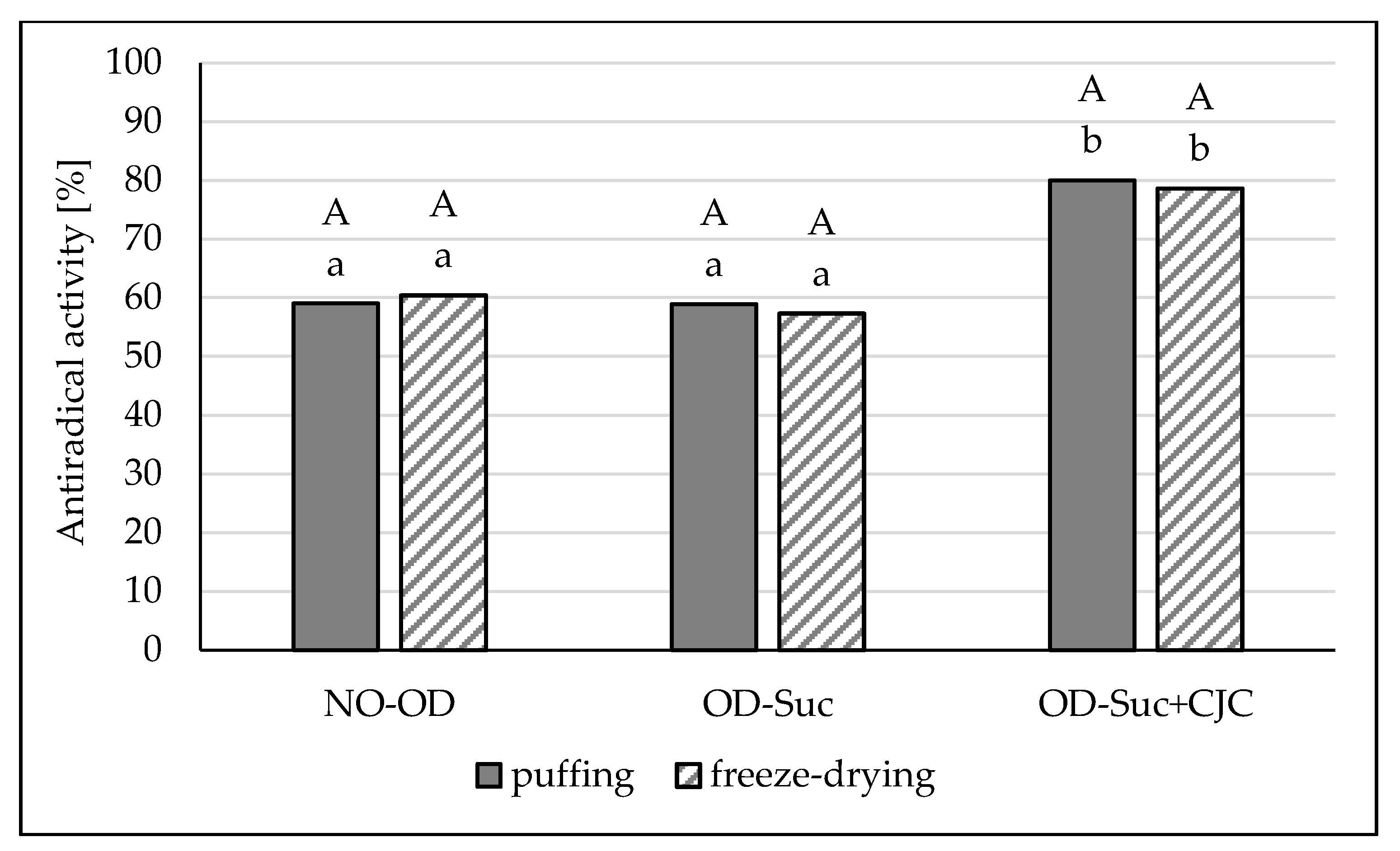
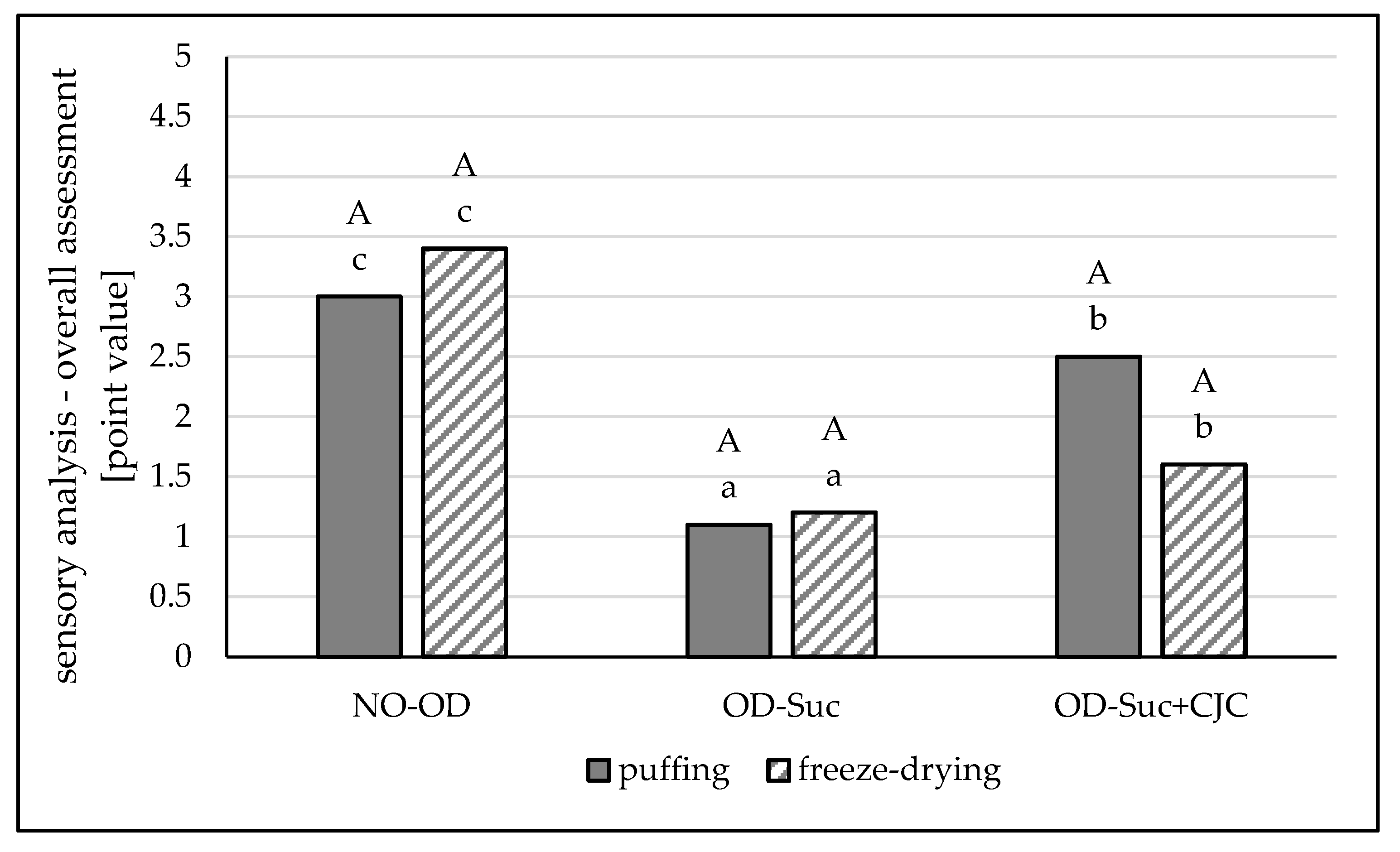
Sample Availability: Samples of the osmotic agents: chokeberry and apple concentrates, sucrose are available from the authors. | |
Publisher’s Note: MDPI stays neutral with regard to jurisdictional claims in published maps and institutional affiliations. |
© 2020 by the authors. Licensee MDPI, Basel, Switzerland. This article is an open access article distributed under the terms and conditions of the Creative Commons Attribution (CC BY) license (http://creativecommons.org/licenses/by/4.0/).
Share and Cite
Kowalska, J.; Marzec, A.; Domian, E.; Galus, S.; Ciurzyńska, A.; Lenart, A.; Kowalska, H. The Use of Antioxidant Potential of Chokeberry Juice in Creating Pro-Healthy Dried Apples by Hybrid (Convection-Microwave-Vacuum) Method. Molecules 2020, 25, 5680. https://doi.org/10.3390/molecules25235680
Kowalska J, Marzec A, Domian E, Galus S, Ciurzyńska A, Lenart A, Kowalska H. The Use of Antioxidant Potential of Chokeberry Juice in Creating Pro-Healthy Dried Apples by Hybrid (Convection-Microwave-Vacuum) Method. Molecules. 2020; 25(23):5680. https://doi.org/10.3390/molecules25235680
Chicago/Turabian StyleKowalska, Jolanta, Agata Marzec, Ewa Domian, Sabina Galus, Agnieszka Ciurzyńska, Andrzej Lenart, and Hanna Kowalska. 2020. "The Use of Antioxidant Potential of Chokeberry Juice in Creating Pro-Healthy Dried Apples by Hybrid (Convection-Microwave-Vacuum) Method" Molecules 25, no. 23: 5680. https://doi.org/10.3390/molecules25235680
APA StyleKowalska, J., Marzec, A., Domian, E., Galus, S., Ciurzyńska, A., Lenart, A., & Kowalska, H. (2020). The Use of Antioxidant Potential of Chokeberry Juice in Creating Pro-Healthy Dried Apples by Hybrid (Convection-Microwave-Vacuum) Method. Molecules, 25(23), 5680. https://doi.org/10.3390/molecules25235680







